Have you ever heard of ruminant animals? If you have livestock, you probably already know that ruminant animals include cattle and sheep. The phrase describes a sizable group of herbivores that have four-chambered stomachs. The majority of ruminants have two-digited hooves, and they are the only mammals capable of digesting food without fully chewing it. Cows, sheep, goats, moose, camels, deer, giraffes, buffalos, and other well-known ruminant species are among them.
In this guide, we’ll explore seven different unique types of ruminant animals. Some of the entries on this list might just surprise you! But first, let’s break down in more depth what a ruminant animal actually is.
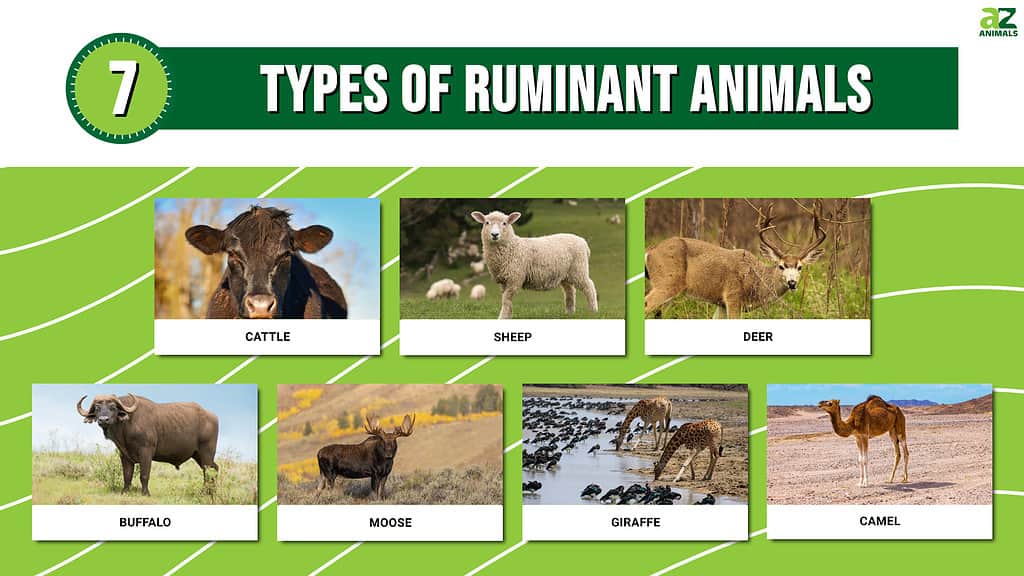
What is a Ruminant Animal?
Various types of ruminant animals may be found all around the world. Cattle, sheep, goats, buffalo, deer, elk, giraffes, camels, and more are examples of ruminants. Every single one of these creatures has a digestive system that is distinctively different from our own.
To start, they have four stomach compartments as opposed to one. The rumen is the biggest of the four compartments and the primary digesting center. Animals with one stomach, such as humans, chickens, and pigs, are unable to digest grass and other coarse plants. However, the rumen is home to billions of microscopic microbes that are capable of doing just that.
When eating grass or other plants, ruminant animals do not entirely chew it. The huge rumen is where the partly chewed grass is kept and converted into cud balls. The animal will relax and chew its cud when it has had its fill of food. The cud is subsequently ingested once more, where it will enter the reticulum, omasum, and actual stomach, the abomasum.
Different Types of Ruminant Animals
The grass, bush, and other vegetation that ruminants consume is converted by them into protein and energy. Based on their preferred diets, they may be divided into three primary groups.
Ruminant animals known as “roughage eaters” consume grass and other high-fiber plant materials. Roughage eaters may digest fermenting material even if they prefer fresh grass. Sheep and cattle are two common examples of agricultural animals that consume roughage.
Concentrate collectors are another type of ruminant animal. Concentrate collectors include creatures like giraffes and deer. They choose plants with high concentrations of nutrients like protein, fat, and carbohydrates that are also easy to digest. Concentrate collectors cannot digest fiber and plant cell cellulose, in contrast to roughage eaters.
The digestive adaptations of concentrate pickers and roughage eaters are present in intermediate ruminants. They can consume both types of plants, albeit they have difficulties breaking down the cellulose found in plant cell walls. Goats, which can consume woody plants, shrubs, and blooming herbaceous plants, are an excellent illustration of intermediate ruminants.
How Young Ruminant Animals Digest Food
When dairy calves are born, their stomachs are divided into four parts. However, for the first several years of their existence, they mostly behave like monogastric or simple-stomached animals.
The rumen, reticulum, and omasum, the first three stomach chambers of a calf, remain dormant and underdeveloped at birth. The calf’s stomach compartments expand and alter as it develops and starts consuming a range of meals. In a newborn calf, the abomasum makes up around 60% of the stomach. This percentage drops to 8% in an adult cow. In a newborn calf, the rumen makes up around 25% of the stomach; this percentage climbs to 80% in an adult cow.
Why Humans Use Ruminant Animals
There are several plants that cannot be eaten directly by humans. Cereal crops cultivated for food contain more than 50% energy that cannot be consumed by humans. These plants and leftovers can be transformed by types of ruminant animals into high-quality protein in the form of meat and milk. Additionally, they eat the trimmings and rejects from the production of fruits and vegetables as well as waste items from food processing facilities.
Now that we have a solid understanding of what ruminant animals are and what they do, let’s take a look at a few species worth knowing.
Cattle
Classification: Bos taurus
This first entry is probably the most well-known of the many types of ruminant animals. Cattle or cows are large, domesticated, cloven-hooved herbivores. They are the most prevalent species of the genus Bos. Cattle are also an important member of the subfamily Bovinae. Adult male cattle and female cattle are referred to as bulls and cows.
For their meat, milk, and skins, which are used to manufacture leather, cattle are frequently reared as livestock. They are also employed as draft animals and for riding. Cattle dung is a byproduct that can be converted into manure for farming or even fuel. Many places, particularly India, place a strong religious focus on the value of livestock. Many tiny breeds of cattle, like the Miniature Zebu, are also kept as pets.
Different geographical regions are home to various breeds of cattle. Most taurine cattle are found in temperate regions of Europe, Asia, the Americas, and Australia. Zebus are mostly found in tropical regions of India, Asia, America, and Australia. The majority of Sanga cattle are located in sub-Saharan Africa. Over 1,000 recognized breeds are further classified into these categories.
Taurine cattle were domesticated some 10,500 years ago in western Iran, the Levant, and central Anatolia from as few as 80 wild aurochs ancestors. Around the globe, similar domestication processes took place. There are more than 1.5 billion cattle in the world today.
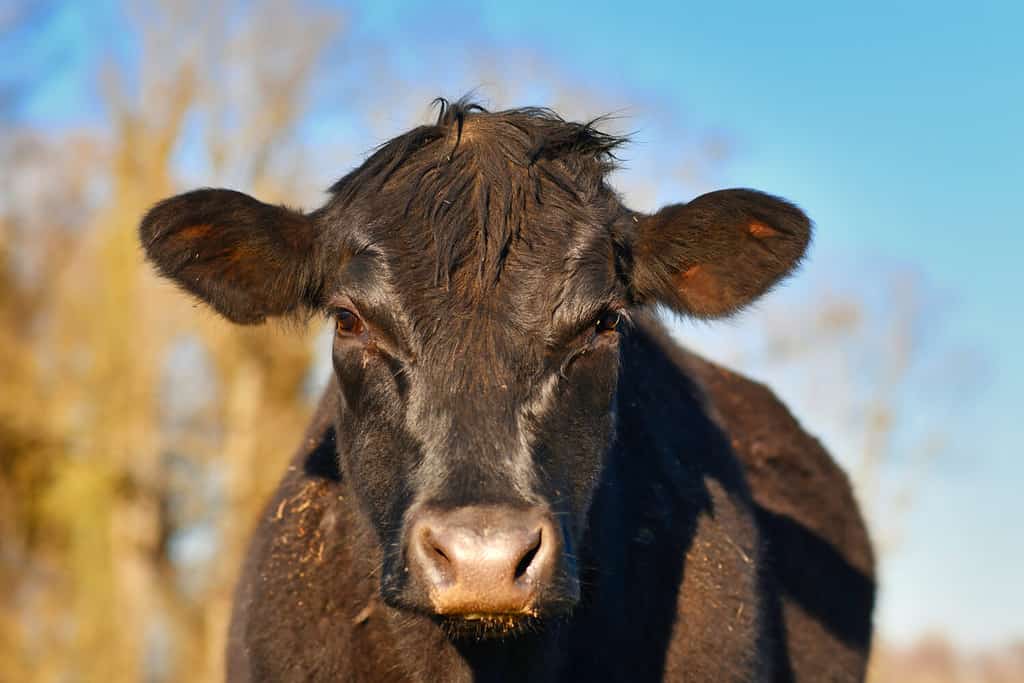
Cattle (pictured) have been used as farm animals for thousands of years.
©Firn/Shutterstock.com
Sheep
Classification: Ovis aries
Sheep are domesticated types of ruminant animals that are frequently raised as livestock. Although other animals of the genus Ovis can sometimes be referred to as sheep, domestic sheep are nearly typically meant when the term “sheep” is used. Sheep are even-toed ungulates of the order Artiodactyla, along with other ruminants.
The wild mouflon of Europe and Asia are likely the ancestors of sheep, with Iran serving as the geographic boundary for the domestication core. Sheep are one of the first animals to be domesticated for use in agriculture. They are farmed for their wool, meat, and milk. The most popular animal fiber in the world is sheep’s wool, which is often obtained by shearing.
Ovine meat from younger animals is referred to as lamb, whereas meat from older animals is referred to as mutton. In the United States, however, meat from both older and younger animals is often referred to as lamb. Sheep are still grown for their wool and meat today. They are also occasionally raised for their pelts, as dairy animals, or as scientific testing animals.
Sheep had a significant role in the development of farming throughout history. They continue to hold a significant cultural position in current language and symbols. These animals are often connected to pastoral, Arcadian images as livestock.

Sheep (pictured) are used more for their wool than for meat, though most cultures do consume their meat.
©patjo/Shutterstock.com
Deer
Classification: Cervidae family
The family Cervidae of hoofed ruminant animals includes the well-known deer. Cervinae, which includes muntjac, elk, red deer, and fallow deer; and Capreolinae, which includes reindeer, white-tailed deer, roe deer, and moose are the two primary subspecies of deer. Most species of male deer develop and lose new antlers every year, a key indicator of whether or not an animal is a deer.
All continents, with the exception of Antarctica and Australia, have native deer populations. Deer can be found in a wide range of biomes, from the tundra to the tropical jungle. Despite being associated with woods, many deer live in transitional areas. This means that they inhabit regions where forests, thickets, prairies, and savannas meet. Around the world, the majority of deer species live in ecosystems such as temperate mixed deciduous woodland, mountain mixed coniferous forest, dry or tropical forest, and savanna.
Deer have been depicted in art since Paleolithic cave paintings and have been significant in mythology, religion, literature, and heraldry throughout history. Their venison, durable buckskin, and antlers all contribute to their economic significance. Since the Middle Ages, deer hunting has been a common pastime and is still a valuable sport for many cultures today.

Deer (pictured) have existed for thousands of years in a wide range of biomes worldwide.
©iStock.com/gatito33
Buffalo
Classification: Bubalina subtribe
Several species of true buffalo are a part of the subtribe of wild cattle known as Bubalina. The African buffalo, anoas, and wild water buffalo are among these species. Sub-Saharan Africa, South Asia, and Southeast Asia are natural habitats for buffalo, while domestic and feral herds have been imported to Europe, the Americas, and Australia. Bubalinans have a diverse fossil record that includes remains that have been discovered over most of Afro-Eurasia in addition to the live species. It’s worth noting that bison belong to the subtribe Bovina, not the Bubalina, despite the fact that they are commonly referred to as buffalo.
The Plains Native Americans relied heavily on buffalo to maintain their way of life and ensure their survival. Due to the scarcity of resources on the Great Plains, the Plains Native Americans devised techniques to make the most of the buffalo. They have traditionally been raised for their meat, dung, fat, fur, hide, horns, and bones.
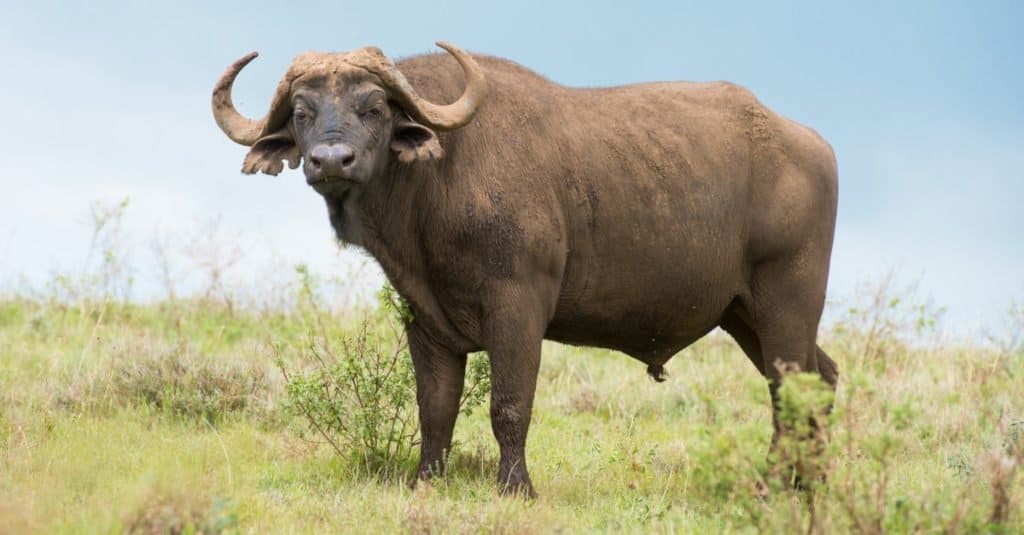
Buffalo (pictured) can be found around the world, particularly in Africa and North America.
©BonnieBC/Shutterstock.com
Moose
Classification: Alces alces
The sole species in the genus Alces, which belongs to the New World deer subfamily, is the moose. It is the deer family’s biggest and heaviest living species. The majority of mature male moose have recognizable wide, hand-shaped antlers, whereas the majority of deer family members have antlers with a dendritic pattern.
Moose often live in moderate to subarctic conditions in boreal forests, temperate broadleaf forests, and mixed forests in the Northern Hemisphere. Over time, the moose’s range has shrunk due to hunting and other human activity. Luckily, many moose have returned to habitat that they had previously disappeared from. At the moment, the countries with the highest concentrations of moose are the United States, Canada, Poland, Kazakhstan, and Russia.
Both land and aquatic plants make up this ruminant animal’s diet. Wolves, bears, people, and even orcas are predators of moose. Moose are solitary animals that do not form herds like most other deer species. Calves will stay with their mothers until the cow enters the estrus cycle, after which they will be shooed away. Moose are typically sluggish and stationary, although they may become aggressive and move very fast if agitated or surprised. Intense battles between males vying for females during their mating season typically occurs around autumn.
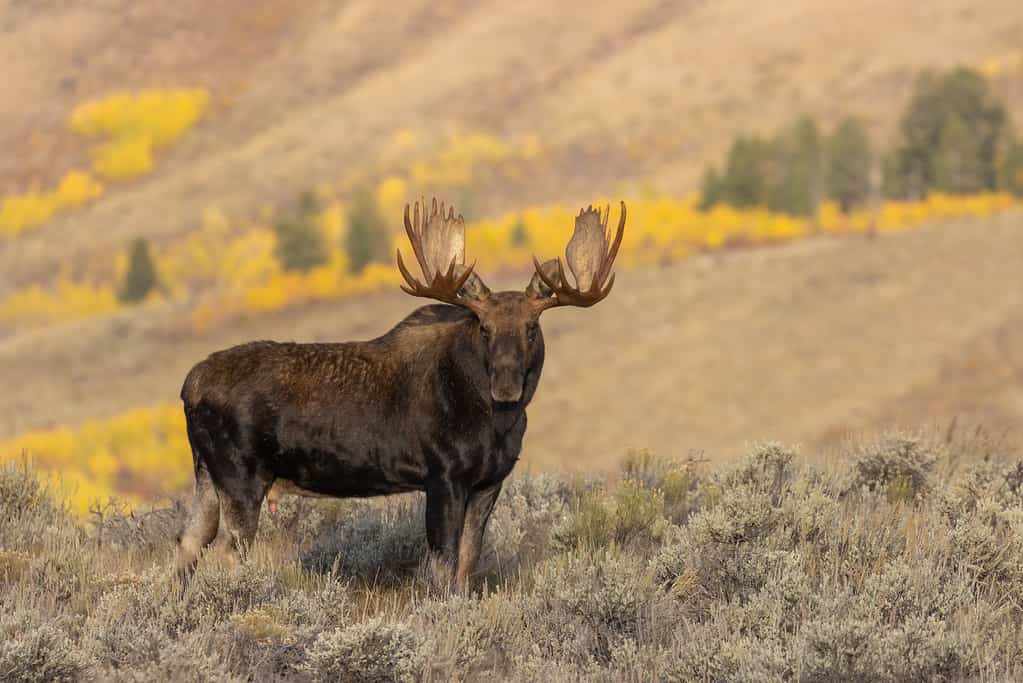
Moose (pictured) are unique in that their antlers are shaped differently than other species of deer.
©Tom Tietz/Shutterstock.com
Giraffes
Classification: Giraffa camelopardalis
Large African hoofed mammals of the genus Giraffa include the giraffe. It is the world’s biggest ruminant animal and the tallest living terrestrial mammal. Giraffa camelopardalis was once considered to be the sole species of giraffes, with nine other subspecies. From fossil records, seven other extinct species of giraffe are now known.
The giraffe’s extraordinarily long neck and skinny legs, horn-like bones on their heads, and unique coat patterns are its most unique features. It belongs to the family Giraffidae, along with the okapi, its closest living cousin.
The dispersed range of this ruminant mammal stretches from Somalia in the east to Niger in the west, and from Chad in the north to South Africa in the south. Typically, savannahs and heavily wooded areas are home to many giraffes. These animals eat the leaves, fruits, and blossoms of woody plants. They graze at heights that are inaccessible to most other herbivores.
Giraffes are often preyed upon by lions, leopards, hyenas, and wild dogs. Giraffes are social and often congregate in huge groups. They live in herds of family-tied females and their offspring. Giraffes can also live in bachelor herds of unrelated males. Males create social hierarchy by necking, a kind of fighting in which their long necks are used as weapons.
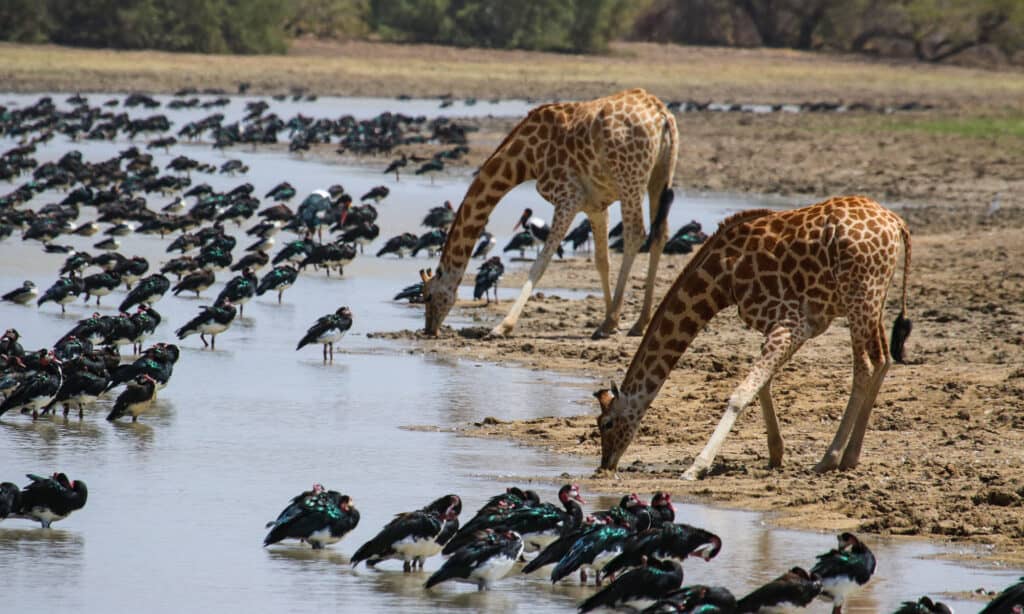
Giraffes (pictured) are ruminant animals as well as opportunists that will eat leaves in addition to fruits and flowers.
©Thomas Clode/Shutterstock.com
Camels
Classification: Camelus genus
Now this is a surprising entry! The camel is an even-toed ungulate and ruminant animal that belongs to the genus Camelus. They are know for their humps, which are fatty deposits that grow on the back of the animal. Since they have long been tamed, camels serve as livestock that provide milk and meat for human consumption. Additionally, they provide textiles in the form of hair felt and fiber. Camels are important modes of transportation for both people and goods since they are working animals that are well adapted to their desert habitat. Three camel species are still in existence. 94% of camels on the planet are one-humped dromedaries, whereas 6% are two-humped Bactrian camels. The wild Bactrian camel, a distinct species, is currently at grave risk of extinction.
The progenitor of modern camels, known as Paracamelus, likely migrated across the Bering land bridge into the continent of Asia around six million years ago. Camelids first appeared in North America during the Eocene Epoch.
Camels’ humps are actually fatty tissue reservoirs rather than empty places where water is kept. For every gram of digested fat, this tissue produces more than one gram of water during metabolism. As energy is released from this fat metabolism, water from the lungs evaporates during breathing.

Camels (pictured) don’t store water in their humps, but rather fat that metabolizes into water.
©amr hassan/Shutterstock.com
Aren’t ruminant species fascinating? These mammals are unique in that they have muli-chambered stomachs and can digest large amounts of roughage without needing to fully chew it all. When it comes down to it, ruminant species have been valuable to humans for over a millennium due to their use as livestock. These animals really do deserve our respect!
Summary of 7 Types of Ruminant Animals With Pictures
| Number | Ruminant Animals |
|---|---|
| 1 | Cattle |
| 2 | Sheep |
| 3 | Deer |
| 4 | Buffalo |
| 5 | Moose |
| 6 | Giraffe |
| 7 | Camel |
The photo featured at the top of this post is © Pitamaha/Shutterstock.com
Thank you for reading! Have some feedback for us? Contact the AZ Animals editorial team.






